- Home Page
- Power Kites
- Surfing Kites
Surfing Kites
C Kites, Bow Kites, and Others
Who hasn't been down to a beach and noticed board riders being drawn along by large surfing kites? Nowadays, it's not just seagulls and swimmers that are a common sight at beaches. A large proportion of the explosion in extreme sports after the year 2000 is the kite-surfing crowd!
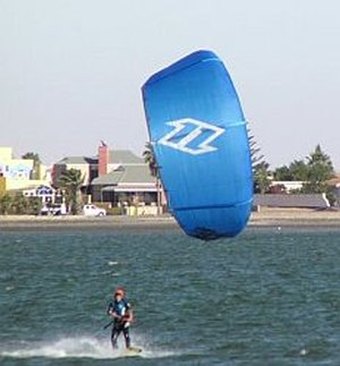 LEI surfing kite
LEI surfing kiteThis is just a very quick introduction to the kites used by these
surfer dudes. This is, after all, a kite site, so I'm choosing to focus
on the engine of this sport rather than the sport itself.
My
family saw quite a bit of kite-surfing action, in a short space of time,
in 2007 at the Adelaide International Kite Festival. The breeze was
howling and the surfers were loving it! There were whitecaps on the ocean and
board riders getting airborne all over the place. We watched from the
jetty in Semaphore.
Are you curious about these big made-for-water traction kites? If so, and if you haven't had the chance to chat about them with a kite surfer, here's an introduction to the four main categories that are flown.
Also, there's a special focus on one of the most popular surfing kites within each category (at least at this writing!).
For the popularity info, I relied on some enthusiastic members of a big Australian water-sports forum. That's not a world-wide survey, but I'm hoping their opinions weren't radically different from the rest of the kite-surfing world!
On this site, there's more kite-making info than you can poke a stick at. :-)
Want to know the most convenient way of using it all?
The Big MBK E-book Bundle is a collection of downloads—printable PDF files which provide step-by-step instructions for many kites large and small.
Every kite in every MBK series.
The C Kite
It's obvious isn't it? A big "C" shape drifts around on the end of those long lines! These were the first surfing kites, and they were designed to float if they came down in water. That's a pretty essential feature for a kite used in the ocean and is achieved by means of an inflatable spar running along the leading edge—the front edge of the kite. Hence these kites are also known as Leading-Edge Inflatables or LEIs, which is less of a mouthful. These kites were also designed to be easily relaunched from the water if necessary. On some designs there are shorter vertical spars that are inflatable too. Actually, it seems surfers talk about "struts" rather than "spars," so we'll use that word from here on!
Why are LEI surfing kites still being used when at least three other types have since been developed? One reason is that they respond in a quick and direct way to control inputs from the board rider. Perhaps the biggest reason is just that they are fairly simple! Everyone likes a kite that just keeps on going with a minimum of wear, tear, and other failures.
I asked around in the forum about which kites appeared to be the most popular. Overwhelmingly, in the C kite category, the choice was:
The Slingshot Fuel
Now for some basic facts on this design:
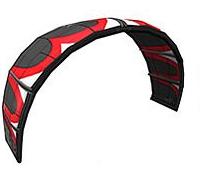 Slingshot Fuel
Slingshot Fuel- There are four flying lines, attached to a bar
- A fifth line, attached to the leading edge, enables the kite to be brought down in a hurry if needed
- Leading edge and other struts are interconnected, so they can all be pumped up in the one operation
- Struts are integrated into the canopy for lighter weight and greater strength in flight
- Sizes range from 7 to 17 square meters of sail area
On that last point, the size is selected according the combination of surfer weight plus the expected wind strengths. Big surfers need big kites, and riding in lighter winds requires bigger kites too.
To cover the full range of weather conditions, a keen rider might have a "quiver" of three surfing kites. The Naish Torch also got some mentions in this category.
The Bow Kite
The Bows were the next generation to come out, and their big selling point was the fact they could handle much bigger wind ranges than the LEIs. They were de-powerable, meaning that the rider could alter the kite's angle of attack to the wind to a large degree. Never mind the aerodynamics, the bottom line is that the pull generated by the kite can be easily reduced, while keeping the kite in the same area of sky. One thing that made this possible was the flatter curve of these kites, compared to the deeper C shape of the LEI. Another practical result of this was that you didn't need two or more surfing kites to cover most wind conditions!
However, there were a few downsides to the early Bow kites. They tended to be a bit harder to fly than the LEI and pulled more heavily on the rider's arms as well. Hence they could be fairly tiring to fly, particularly in strong wind. Finally, if a Bow hit the water it could be trickier to relaunch than the equivalent LEI.
And which one was our forum kite surfers' favorite?
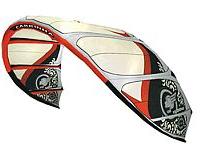 Cabrinha Crossbow
Cabrinha CrossbowThe Cabrinha Crossbow
Again, here are a few basic facts:
- There are four flying lines, attached to a bar with a pulley system
- Full de-power is achieved by pushing the bar away—past a certain point, the kite drops to the water
- Leading edge and other struts are interconnected so they can all be pumped up in the one operation
- Struts are integrated into the canopy for lighter weight and greater strength in flight
- Sizes come in 7, 9, 10.5, and 12 square meters of sail area
The BEST Waroo also got plenty of votes, followed by the Ozone Instinct.
The Hybrid Kite, or SLE Kite
By 2006, kite designers really excelled in striving for the best of both worlds. They managed to combine the easy relaunching characteristics and moderate bar pressures of the original C kites with the 100 percent de-power ability and higher performance of the early flat LEI kites. Hence the term hybrid, which just refers to the combining of two things together—kite design in this case.
A noticeable feature of these hybrid surfing kites is the supported leading edge or SLE, where a series of bridle lines attach to various points across the kite's leading edge. Hence many riders refer to these kites as SLEs. The handling of these kites has been developed to the point where even beginners can soon master the required flying skills.
Apparently, there's a lot of these SLEs around now, but in March 2008 the forum poll showed up a clear favorite:
The Slingshot REV
Here are a few facts about this one:
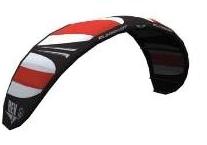 Slingshot Rev
Slingshot Rev- There are four flying lines, attached to a "directdrive" bar with no pulleys
- Full de-power is achieved by pushing the bar away—past a certain point, the kite drops to the water
- Sizes come in 5, 7, 9, 11, 13, and 15 square meters of sail area
Other hybrids that got a few mentions were the Flexifoil Atom and North Rebel designs.
It's worth mentioning here that a typical new inflatable kite of any type comes with the following items:
- User manual
- Carry bag
- Pump
- Repair kit
The Parafoil Kite
The parafoil kite, or just foil (as many abbreviate it), is much different to the other three types already mentioned. This type is much like a parachute, in that it is completely flexible and relies on many bridle lines to hold its C shape in the air. Like most land-based kites these days, ripstop nylon is the usual sail fabric. These surfing kites have upper and lower surfaces with ribs sewn in between to form cells. When in flight, air pressure inflates the cells, giving the kite a wing-like shape that generates lift—just like an aircraft wing.
What about when one of these kites hits the water? The designers have taken care of kite-surfers here by providing an extra feature—inlet valves! Air can force its way in while the kite is flying, but otherwise the valves stay shut, keeping the kite inflated. Hence it doesn't sink once it hits the water and can be relaunched fairly easily. Parafoils designed for water in this way are known as closed-cell foils.
Since you don't need a pump to inflate a foil, these are also known as self-inflatable kites. The latest surfing kites of this type (at least at this writing!) have wide de-power ranges, just like Bows or SLEs. Hence they can be flown in a wide range of wind conditions.
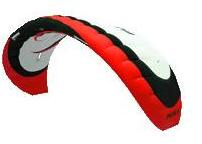 Flysurfer Pulse 2
Flysurfer Pulse 2It seems that not all the guys in the forum like parafoils, but among those who don't mind them, one design stands out:
The Flysurfer Pulse 2
Here are a few basic facts about this kite:
- There are four flying lines, attached to a bar
- Full de-power is via a fifth line, to dump lift in emergencies or to land the kite
- Sizes come in 6, 8, 10, and 12 square meters of sail area
Honorable mentions must also go to the Peter Lynn Venom, Flexifoil Blade III, and the Flysurfer Speed in this category!
Surfing Kites: Conclusion
This has been just a glimpse into the world of surfing kites, from the perspective of a non-surfer. It's a snapshot of the surfing kites that were used by Australian riders in 2008. If you knew nothing when you arrived on this page, I hope you now have at least some appreciation for these specialized power kites!
Many thanks to the real experts from the kite-surfing forum at Seabreeze.com.
As mentioned earlier, there's more kite making on this site than you can poke a stick at. :-)
Want to know the most convenient way of using it all?
The Big MBK E-book Bundle is a collection of downloads—printable PDF files that provide step-by-step instructions for many kites large and small.
That's every kite in every MBK series.
